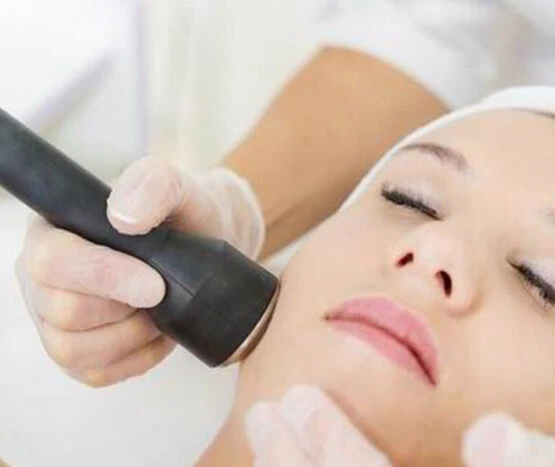Laser Acne Treatment
Everyone gets acne from time to time. Some are lucky to leave it behind in adolescence, while others deal with it well into adulthood. Thanks to our advances in cosmetic technologies, you don’t have to suffer the pain and embarrassment of acne any longer.
Laser acne treatment is an effective, painless way to treat both acne and the scars it can cause. By applying gentle laser light to the skin, your face, back, chest or other areas can be cleared of acne pustules without the application of harsh creams or ointments. In addition, the laser smooths your skin, minimizing the appearance of scars, uneven texture, and hyperpigmentation.
A Brief Overview of Acne
Acne is the result of the excess production of sebum, an oil naturally created by the body to moisturize and protect the skin. Too much sebum, mixed with dirt and dead skin cells, can lead to blocked pores. The pores become infected and inflamed, producing red pustules on the face: acne.
A few different types of acne exist, measured by their severity. Mild acne can include whiteheads and blackheads, as well as pustules. Cystic and nodular acne are more severe, causing small, painful lumps under the skin, which often leave red marks. Acne commonly appears on the face, but can also appear on the back, neck, shoulders, chest, and buttocks. All types and areas—including any scarring that remains—can be improved with laser acne treatments.
Why do we Get Acne?
The number one reason is puberty. The fluctuations in hormone levels can wreak havoc on your skin.
Other causes include, but aren’t limited to the menstrual cycle, menopause, genetics, and certain types of medication, especially birth control pills as they are hormone-based etc.
How to Treat Bacne (acne on back)
Many people use a specific term to describe acne that occurs on the back: bacne. It’s quite common in both men and women, and if it’s severe enough, it can lead to a fear of exposing your back in social or intimate situations.
Bacne can and should be treated just like acne on the face, as they share the same cause—overactive sebum production, and clogged pores. Laser acne treatment can be effective in fighting not just bacne, but acne that occurs on the shoulders and chest as well. In addition, if acne in any of those locations has resulted in scarring, laser acne treatment may help to reduce the visibility of those scars. After laser acne treatment, you won’t have to be embarrassed to wear skin-exposed clothings, sarees etc.
Acne Scar Removal
Maybe you’ve been fortunate, and your adolescent or adult acne has finally cleared up thank to your diligent skin care regimen. However, you may still have a reminder of that condition in the form of acne scarring.
Some acne scars fade on their own over time. Some scars may be small and barely noticeable, while others are highly visible, and even appear as pockmarks or depressions in the skin. This type of scarring creates an uneven skin surface, and can sometimes also cause discoloration of the skin called hyperpigmentation, which only draws more attention to the scarring. Whether your acne scars are small or prominent, acne scar removal can help.
Our gentle laser is specifically designed to treat the uppermost layers of skin without causing further damage to its delicate structure. For this reason, it’s called a non-ablative (non-wounding) laser.
When this laser is applied to the skin, the scar is exposed to fractional microbeams of laser energy that penetrate the affected skin to stimulate the creation of fresh tissue. In the time following a series of sessions, the scar gradually fades or disappears. Treatment with this device is virtually painless, and requires no anesthesia, and no downtime afterward.
Some deep scarring may require the use of a more aggressive treatment called dermabrasion. This essentially equates to sanding the skin to remove several layers, and even them out with the deep scarring, thereby eliminating the depressions in the skin. This is a surgical procedure, and requires administration of local or general anesthesia, as well as a lengthy recovery period.
Types of Acne Scarring
Acne sometimes results in one of two types of scars: atrophic and hypertophic.
Atrophic Acne Scarring
This type of scarring can be broken down into five general subcategories:
- Depressed Fibrotic Scars: Large depressions in the skin that sometimes appear jagged.
- Ice Pick Scars: A milder version of depressed fibrotic scars. The depression in the skin is smaller, but just as deep. They are the most common type of acne scar, and may lead to depressed fibrotic scars
- Soft Scars: Smaller than most acne scars, they’re usually round or appear as lines that meld into the surrounding skin.
- Atrophic Macules: These appear as purplish or bluish spots, generally fading into a shade paler than the surrounding skin. They may grow to more than a centimeter in diameter.
- Perifollicular Elastolysis Scars: Also known as follicular macular atrophy, they are small, raised lesions. They look a lot like underdeveloped whiteheads.
Hypertrophic Acne Scarring
This occurs when an excess amount of collagen is produced, leading to the formation of large growths on the skin. These become what are known as keloid scars. Hypertrophic scarring is the less common form of acne scarring.

